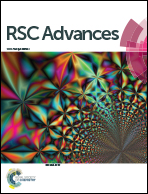Solvatochromic studies of pull–push molecules containing dimethylaniline and aromatic hydrocarbon linked by an acetylene unit†
Abstract
Pull–push molecules containing dimethylaniline and aromatic hydrocarbon linked by an acetylene unit were studied using spectroscopic methods and DFT theoretical calculations. Spectral and photophysical properties of N,N-dimethyl-4-(naphthalen-1-ylethynyl)aniline, N,N-dimethyl-4-(naphthalen-2-ylethynyl)aniline, 4-(athracen-9-ylethynyl)-N,N-dimethylaniline were studied in 26 solvents (non-polar, polar aprotic and protic). The influence of solvent properties on the spectral and photophysical properties of the compounds studied was analyzed using empirical Riechardt's solvent polarity index as well as Catalán and Kamlet–Tatf multi-parameter solvent scales. The change of the dipole moment in the excited state was estimated based on Bilot–Kawski theory. Using the solvatochromic method, the change of hydrogen bond energy in the excited state was calculated. Theoretical calculations confirm the conclusions arising from experimental studies.


 Please wait while we load your content...
Please wait while we load your content...